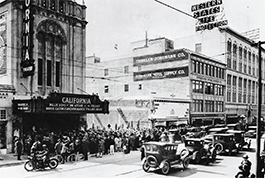home | metro silicon valley index | the arts | visual arts | preview

Photograph Courtesy History San Jose
Glory Days: San Joseans turned out on April 16, 1927, for the opening of the California Theatre.
Screening The Past
Gary Lee Parks illustrates history of San Jose theaters in nostalgia-rich new book
By Gary Singh
GENERATIONS of armchair San Jose historians will find it difficult to ignore any book with the following sentence on the back cover: "Even such relative newcomers as the Century 21 Theatre and its fellow domed cinemas have begun to gain a romance of their own." Thanks to Gary Lee Parks, the romance is now documented in Theatres of San Jose, yet one more Images of America book from Arcadia Publishing.
These are the old-school black-and-white photo books documenting forgotten neighborhoods, towns, ancient sports teams, universities or, in this case, theaters. We have already been blessed with Theatres of San Francisco and Theatres of Oakland, so the time is right for a San Jose edition.
Theatres of San Jose begins with early theaters and 5-cent movie houses before moving on to the glory days of San Jose movie palaces from the 1920s to the 1940s. Back in those days, downtown San Jose was a thriving locale, filled with theaters and retail. The streets were always jammed. People flocked to places like the Mission Theatre, the Liberty Theatre and the Jose Theatre, which is now the San Jose Improv.
Parks even devotes an entire chapter to the California Theatre, San Jose's grand dame, which opened in 1927 before going through decades of face-lifts, structural changes, renamings and dark periods before finally re-emerging as a fully restored beauty five years ago.
As in all Arcadia books, the photos themselves tell the stories. The captions only add to the mystique. On page 82, we see that what is now the Towne Theater used to be the Hester Theatre. Parks says he found a newspaper article claiming that the theater originally exhibited an Egyptian-style interior when it first opened in the late '20s but insists it had nothing to do with the Rosicrucians, who originally set up shop not too far away, around the same time.
What's more, the book tells a few stories of theaters that never actually happened. For example, consider the legendary southwest corner of Bascom Avenue and San Carlos Street, where one finds Time Deli, Alex's 49er Inn and Saver's thrift store. On page 87, Parks reveals an artist's rendering of what was supposed to be the original Garden Theatre--right in the middle of that quarter-circle strip mall. Otto A. Deichmann designed the theatre, but eventually the plans gave way and the Garden Theatre opened in Willow Glen instead.
The last chapter, "Domes and Starlight," depicts the last vestiges of San Jose's drive-in era, with haunting images of such forgotten landmarks as the El Rancho Drive-In, which in 1950 opened at 1505 Almaden Road. Today, El Rancho Liquors at Almaden and Alma sits right across from where the drive-in used to be. On page 124, we see a landscape shot of the Tropicaire Twin Vue at 1969 Alum Rock Blvd. A throwback to the golden age of tiki, torches and palm trees, the image looks straight out of early 1950s Las Vegas. There was not much else on Alum Rock Boulevard in those days.
An interesting side note: Both of these theaters were opened by Paul Catalana, before his legendary days as a rock promoter a decade later. Catalana would achieve much greater renown by bringing the Beatles to San Francisco in 1964 and the Rolling Stones to the San Jose Civic Auditorium in 1965.
Other long-forgotten masterpieces making appearances in the book include the Spartan Drive-in, which closed in 1976, and the Fox Bayshore Drive-in, which was located at First Street and Brokaw 45 years ago.
And one could not possibly concoct a history of theater architecture in San Jose without including the famous domes of the Century Theatres. Constructed in the mid-to-late-'60s, right when drive-ins were proliferating throughout the suburbs and rural areas, the Centurys offered a "modernistic tribute to the world of tomorrow," as Parks explains it.
The real attraction was presentation technology: "The theaters themselves were very comfortable, but the main amenities promoted by the exhibitors were the wide screens, superior sound and projection, and clarity of image and color, which television could never hope to match. This, however, was the last mighty gasp of traditional movie showmanship prior to the multiplex era."
THEATRES OF SAN JOSE, by Gary Lee Parks; Images of America Series, Arcadia Publishing; 128 pages; $21.99 paper
Send a letter to the editor about this story.
|
|
|
|
|
|